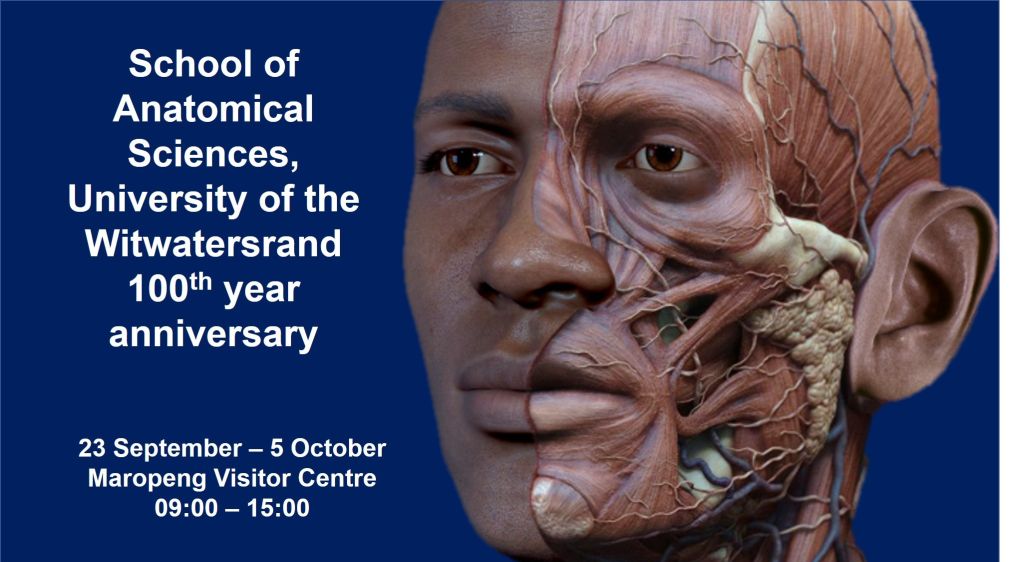Humanity’s past, present and future meet in Maropeng’s #ANATOMY100 public outreach exhibition
The author Ayn Rand wrote that “the beauty of the human body is that it hasn’t a single muscle which doesn’t serve its purpose … there’s not a line wasted”. Find out more about the scientific marvel that is the human body at the fascinating #ANATOMY100 public outreach exhibit, which runs at Maropeng from 23 September to 5 October 2019.
This temporary exhibition has been curated to celebrate 100 years of excellence by the School of Anatomical Sciences at the University of the Witwatersrand. The school boasts a long and proud history of palaeoanthropology and research ever since it saw the light of day as the Department of Anatomy in 1919.
Anyone who is interested in the mysteries of the human body will uncover intriguing food for thought at the #ANATOMY100 exhibition. There are fun-filled and interactive activities for budding young doctors, anatomists, neuroscientists, embryologists and forensic anthropologists, too.
Highlights include plastic models demonstrating the beauty and complexity of the human anatomy, a neuroscience-based brain puzzle and a mock excavation of a plastic skeleton.
Scratching your head over the definition of cell mitosis in your Life Sciences textbook? Check out a microscopically strained onion to see a practical demonstration of how this process works. Plus, you can observe how DNA is extracted from a strawberry – bringing biology and science to life in a hands-on way.
“I’m very excited to able to share with the public a little sneak peak into the University department which I called my second home on campus during my PhD studies,” says Maropeng’s curator, Keneiloe Molopyane.

Those who are interested in pursuing a career in anatomy can find out more about the academic fields that you can follow and what opportunities are available, while learning about the school’s current research projects.
Have you ever thought of donating your body to medical science after your death? Your donation can make a valuable contribution to advancing research, training future generations of medical professionals, and adding to our “body” of anatomical knowledge for the betterment of society. Find out more about the school’s body donor programme during the exhibition.
Anja Meyer, a lecturer at the School of Anatomical Sciences, describes how invaluable the gift of body donation has been to her studies and research. As a student, she spent months becoming acquainted with the bones of the first skeleton assigned to her, and developed a close appreciation for, and understanding of, the individual. “I came to realise who the person behind the skeleton was,” she says.
It was a woman in her 60s. Meyer discovered that the woman had been a bit shorter than her, had broken her arm at some stage in her life, and had had children, based on the scars on her pelvic bones.
“For me, it was absolutely amazing, as I would never have thought I would be able to learn and gain so much from a skeleton,” she says. “It’s wonderful that I can still use this knowledge today in my daily work and in my research. I might not know the name of that woman, but I will always be grateful to her and her family.”
She says she sees that same excitement today among her own students, whose initial trepidation at dissecting a cadaver is “transformed into an absolute appreciation and a realisation not only of how their own bodies work, but also of how one day they can use that knowledge to help their patients”.
Meyer continues to have a deep reverence for the value that the human body adds to medical knowledge: “I think there’s no reference source on Earth that can provide you with such a wealth of knowledge and the necessary experience.”
The #ANATOMY100 exhibition may be viewed at the Maropeng Visitor Centre from 9am to 3pm daily, until 5 October 2019. Come and see how humanity’s past meets the present in a dynamic way, and how each of us can benefit future generations by contributing to science’s understanding of the human body. Regular Maropeng admission fees apply.